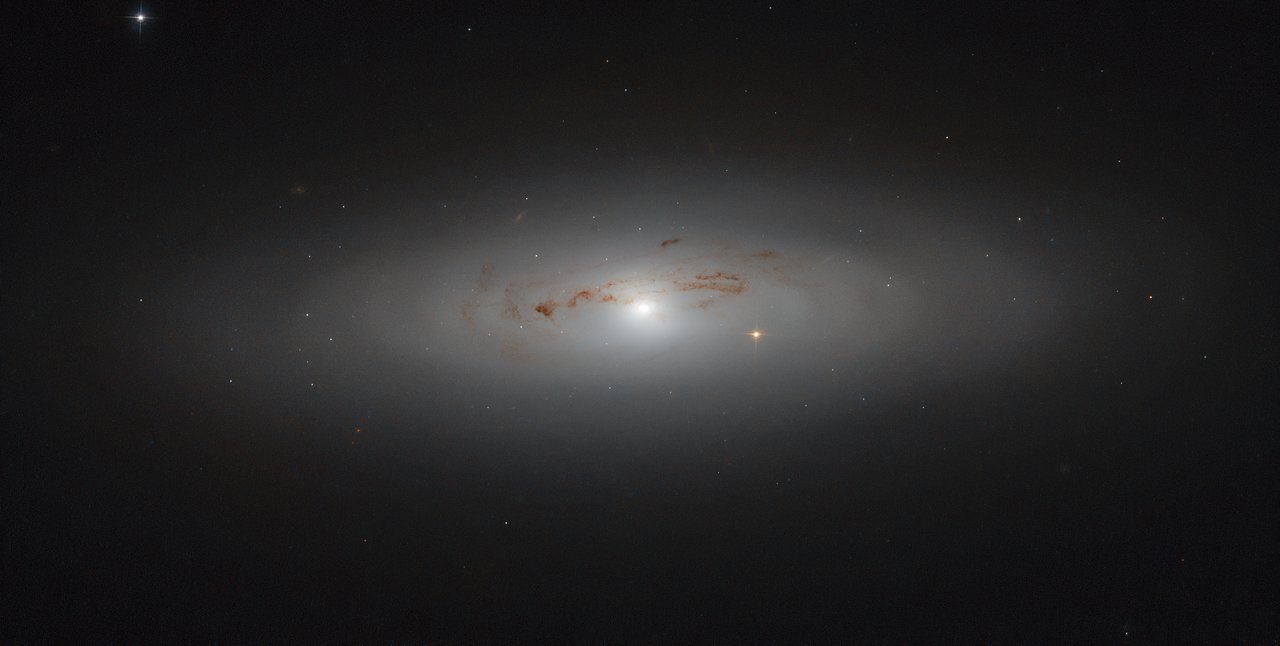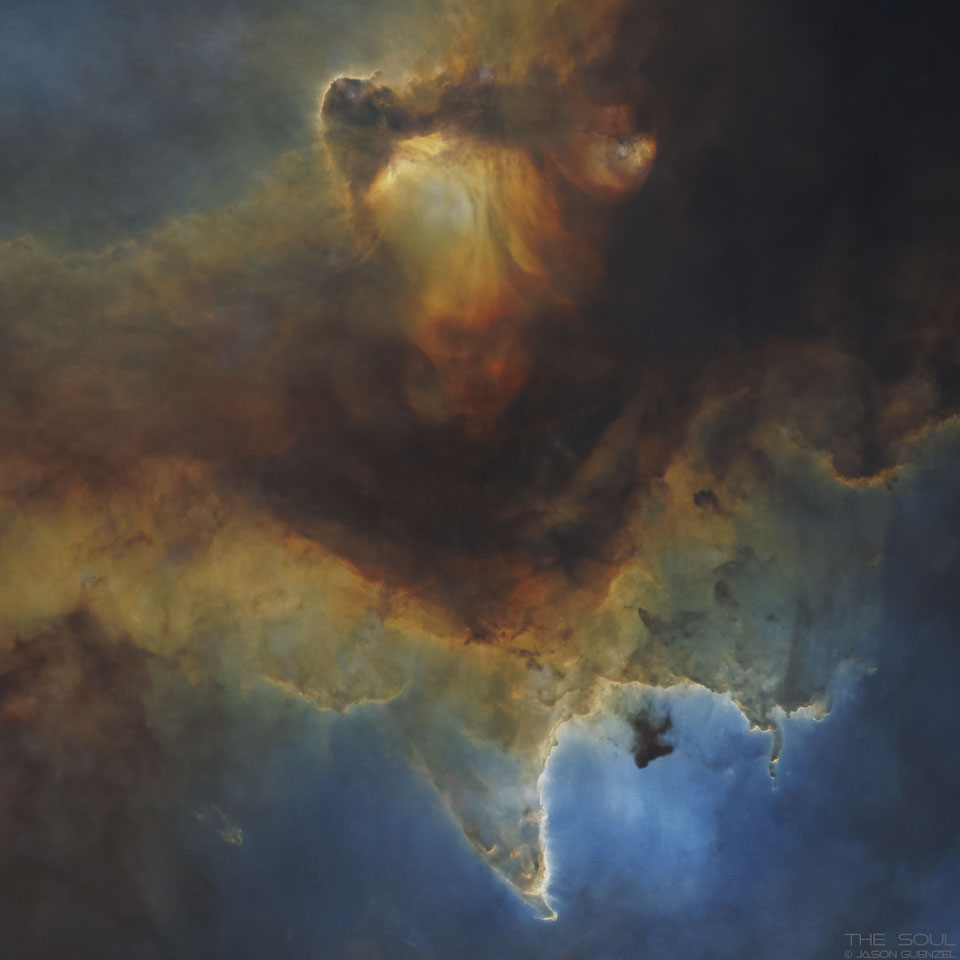Blog
The galaxy NGC 4036: a lenticular galaxy some 70 million light-years away in the constellation of Ursa Major (the Great Bear). This galaxy is known for its irregular lanes of dust, which form a swirling spiral pattern around the centre of the galaxy. This core is surrounded by an extended, hazy aura of gas and dust that stretches further out into space and causes the warm, fuzzy glow that can be seen here. The centre itself is also intriguing; it is something known as a LINER-type (Low-Ionisation Nuclear Emission-line Region) galactic nucleus, meaning that it displays particular emission lines within its spectrum. The particularly bright star visible slightly to the right of the galactic centre is not within the galaxy itself; it sits between us and NGC 4036, adding a burst of brightness to the scene. Due to its relative brightness, this galaxy can be seen using an amateur telescope, making it a favourite amongst backyard astronomers and astrophotography aficionados.

Walter Louis Garland (11 November 1930 – 27 December 2004) professionally Hank Garland, was an American guitarist and songwriter. He started as a country musician, played rock and roll as it became popular in the 1950s, and released a jazz album in 1960. His career was cut short when a car accident in 1961 left him unable to perform. 2007 saw the release of the Hank Garland biopic Crazy.
Born in Cowpens, South Carolina, Garland began playing guitar at the age of six. He appeared on local radio shows at 12 and was discovered at 14 at a South Carolina record store.
more...Ernestine Anderson (November 11, 1928 – March 10, 2016) was an American jazz and blues singer. In a career spanning more than six decades, she recorded over 30 albums. She was nominated four times for a Grammy Award. She sang at Carnegie Hall, the Kennedy Center, the Monterey Jazz Festival (six times over a 33-year span), as well as at jazz festivals all over the world. In the early 1990s she joined Qwest Records, the label founded by fellow Garfield High School graduate Quincy Jones.
Ernestine Irene Anderson (and her twin sister Josephine) were born in Houston, Texas, on November 11, 1928. Her mother, Erma, was a housewife, and her father, Joseph, a construction worker who sang bass in a gospel quartet. By the age of three, Anderson showed a talent for singing along with her parents’ old blues 78 rpm records by the likes of Bessie “The Empress of the Blues” Smith. Anderson started singing at a local church, singing solos in its gospel choir.
https://www.youtube.com/watch?v=LPGwUYOTe0Y
more...Mose John Allison Jr. (November 11, 1927 – November 15, 2016 Tippo, MS) was an American jazz and blues pianist, singer, and songwriter. He became notable for playing a unique mix of blues and modern jazz, both singing and playing piano. After moving to New York in 1956, he worked primarily in jazz settings, playing with jazz musicians like Stan Getz, Al Cohn, and Zoot Sims, along with producing numerous recordings.
He is described as having been “one of the finest songwriters in 20th-century blues.” His songs were strongly dependent on evoking moods, with his individualistic, “quirky”, and subtle ironic humor. His writing influence on R&B had well-known fans recording his songs, among them Pete Townshend, who recorded his “Young Man Blues” for the Who‘s Live at Leeds album in 1970. John Mayall was one of dozens who recorded his classic, “Parchman Farm“, and Georgie Fame used many of Allison’s songs. Others who recorded his songs included Leon Russell (“I’m Smashed”) and Bonnie Raitt (“Everybody’s Crying’ Mercy”).
The 1980s saw an increase in his popularity with new fans drawn to his unique blend of modern jazz. In the 1990s he began recording more consistently. Van Morrison, Georgie Fame and Ben Sidran collaborated with him on a tribute album, Tell Me Something: The Songs of Mose Allison. The Pixies wrote the song “Allison” as a tribute.
Allison’s music had an important influence on other artists, such as Jimi Hendrix, J. J. Cale, the Yardbirds, the Rolling Stones, Tom Waits, and Pete Townshend. He was inducted into the Long Island Music Hall of Fame in 2006.
more...This cosmic close-up looks deep inside the Soul Nebula. The dark and brooding dust clouds near the top, outlined by bright ridges of glowing gas, are cataloged as IC 1871. About 25 light-years across, the telescopic field of view spans only a small part of the much larger Heart and Soul nebulae. At an estimated distance of 6,500 light-years the star-forming complex lies within the Perseus spiral arm of our Milky Way Galaxy, seen in planet Earth’s skies toward the constellation Cassiopeia. An example of triggered star formation, the dense star-forming clouds in the Soul Nebula are themselves sculpted by the intense winds and radiation of the region’s massive young stars. In the featured image, stars have been digitally removed to highlight the commotion in the gas and dust.

more...
Russell Charles Means (November 10, 1939 – October 22, 2012) was an Oglala Lakota activist for the rights of Native Americans, libertarian political activist, actor, writer and musician, who became a prominent member of the American Indian Movement (AIM) after joining the organization in 1968 and helped organize notable events that attracted national and international media coverage.
Means was active in international issues of indigenous peoples, including working with groups in Central and South America and with the United Nations for recognition of their rights. He was active in politics at his native Pine Ridge Indian Reservation and at the state and national level.
Beginning an acting career in 1992, he appeared on numerous television series and in several films, including The Last of the Mohicans and released his own music CD. He published his autobiography Where White Men Fear to Tread in 1995.
more...Wilbert Thirkield “Big Chief” Ellis (November 10, 1914 – December 20, 1977) was an American blues pianist and vocalist.
Ellis was born in Birmingham, Alabama, United States, and was an autodidact at piano. He played at local parties and dances in the late 1920s before leaving Alabama, traveling the United States and working odd jobs. He served in the Army from 1939 to 1942, then moved to New York City, where he accompanied touring blues performers for their concerts in the city. He recordedwith Lenox Records in 1945, and recorded for Capitol Records with Sonny Terry and Brownie McGhee in the 1950s.
In 1972, Ellis moved to Washington, D.C., where he operated a liquor store. Towards the end of his life, Ellis began recording for Trix Records, where he played again with McGhee as well as Tarheel Slim and John Cephas.
Ellis died in Birmingham, Alabama, of heart failure aged 63
more...Hubert Laws (born November 10, 1939) is an American flutist and saxophonist with a career spanning over 40 years in jazz, classical, and other music genres. Considering the artistry of the late Eric Dolphy and the popularity of the late Herbie Mann, Laws is notably in the company of the most recognized and respected jazz flutist in the history of jazz, (also the most imitated). Laws is one of the few classical artists who has also mastered jazz, pop, and rhythm-and-blues genres, moving effortlessly from one repertory to another.
Hubert Laws, Jr. was born November 10, 1939, in the Studewood section of Houston, Texas, the second of eight children to Hubert Laws, Sr. and Miola Luverta Donahue. Many of his siblings also entered the music industry, including saxophonist Ronnie and vocalists Eloise, Debra and Johnnie Laws. He began playing flute in high school after volunteering to substitute for the school orchestra’s regular flutist. He became adept at jazz improvisation by playing in the Houston-area jazz group the Swingsters, which eventually evolved into the Modern Jazz Sextet, the Night Hawks, and The Crusaders. At age 15, he was a member of the early Jazz Crusaders while in Texas (1954–60), and also played classical music during those years.
more...Hyman Paul Bley, CM (November 10, 1932 – January 3, 2016) was a Canadian pianist known for his contributions to the free jazz movement of the 1960s as well as his innovations and influence on trio playing and his early live performance on the Moog and Arp audio synthesizers. Bley was a long-time resident of the United States. His music has been described by Ben Ratliff of the New York Times as “deeply original and aesthetically aggressive”. Bley’s prolific output includes influential recordings from the 1950s through to his solo piano records of the 2000s.
Bley was born in Montreal, Quebec, on November 10, 1932. His adoptive parents were Betty Marcovitch, an immigrant from Romania, and Joe Bley, owner of an embroidery factory. However, in 1993 a relative from the New York branch of the Bley family walked into the Sweet Basil Jazz Club in New York City and informed him that his father was actually his biological parent. At age five Bley studied violin, but at age seven he decided to switch to the piano. By eleven he received a junior diploma from the McGill Conservatory in Montreal. At thirteen he formed a band which played at summer resorts in Ste. Agathe, Quebec. As a teenager he played with touring American bands, including Al Cowan’s Tramp Band. In 1949, when Bley was starting his senior year of high school, Oscar Peterson asked Bley to fulfill his contract at the Alberta Lounge in Montreal. The next year Bley left Montreal for New York City and Juilliard.
more...Carl W. Stalling (November 10, 1891 – November 29, 1972) was an American composer and arranger for music in animated films. He is most closely associated with the Looney Tunes and Merrie Melodies shorts produced by Warner Bros., where he averaged one complete score each week, for 22 years. Stalling was born to Ernest and Sophia C. Stalling. His parents were from Germany; his father arrived in the United States in 1883. The family settled in Lexington, Missouri where his father was a carpenter. He started playing piano at six. By the age of 12, he was the principal piano accompanist in his hometown’s silent movie house. For a short period, he was also the theatre organist at the St. Louis Theatre, which eventually became Powell Symphony Hall.
more...Raise your arms if you see an aurora. With those instructions, two nights went by with, well, clouds — mostly. On the third night of returning to same peaks, though, the sky not only cleared up but lit up with a spectacular auroral display. Arms went high in the air, patience and experience paid off, and the creative featured image was captured as a composite from three separate exposures. The setting is a summit of the Austnesfjorden fjord close to the town of Svolvear on the Lofoten islands in northern Norway. The time was early 2014. Although our Sun has just passed the solar minimum of its 11-year cycle, surface activity should pick up over the next few years with the promise of triggering more spectacular auroras on Earth.

Mary Allin Travers (November 9, 1936 – September 16, 2009) was an American singer-songwriter and member of the folk music group Peter, Paul and Mary, along with Peter Yarrow and Paul Stookey. Peter, Paul and Mary was one of the most successful folk music groups of the 1960s.Travers, unlike most folk musicians of the early 1960s who were a part of the burgeoning music scene, grew up in New York City‘s Greenwich Village. A contralto, Travers released five solo albums in addition to her work with Peter, Paul and Mary.
Mary Travers was born in Louisville, Kentucky, to Robert Travers and Virginia Coigney, journalists and active organizers of The Newspaper Guild, a trade union. In 1938, the family moved to Greenwich Village in New York City.
Mary attended the progressive Little Red School House, where she met musical icons like Pete Seeger and Paul Robeson. Robeson sang her lullabies. Travers left school in the 11th grade to become a member of the Song Swappers folk group.
more...November 9th 1955
Lynn Baker is an active saxophone performer and clinician, performing with his own Lynn Baker Quartet, the free-improvisation trio Rhythmic_Void, performing with and directing the Rocky Mountain Jazz Repertoire Orchestra, and programming the jazz series at the Cherokee Ranch and Castle Performing Arts Series. His clinician appearances at colleges, universities, high schools, and festivals have taken him across the North American continent and to Asia. He is a Origin Records recording artist with his debut release on that label scheduled for September 2010.
Lynn is an award-winning composer, performer, and educator winning the 1987 Westside Composer Award (Minneapolis, MN), the 1995 COVisions Award for Jazz Composition, the 1980 Ruth Loraine Close award in performance from the University of Oregon, and the 2005 Downbeat Magazine award for Outstanding Achievement in Jazz Education �” College Level and students and ensembles from Lamont are frequent Downbeat Student Music Award winners.
more...Milton Mesirow (November 9, 1899 – August 5, 1972), better known as Mezz Mezzrow, was an American jazz clarinetist and saxophonist from Chicago, Illinois. He is well known for organizing and financing historic recording sessions with Tommy Ladnier and Sidney Bechet. He also recorded a number of times with Bechet and briefly acted as manager for Louis Armstrong. Mezzrow is equally well remembered as a colorful character, as portrayed in his autobiography, Really the Blues (which takes its title from a Bechet composition), co-written with Bernard Wolfe and published in 1946.
Along with his other white counterparts, such as Eddie Condon and Frank Teschemacher, Mezzrow would visit the Sunset Café to learn from and listen to Louis Armstrong and his Hot Five. He admired Armstrong so much that after the release of “Heebie Jeebies”, he, along with Teschemacher, drove 53 miles to Indiana in order to play it for Bix Beiderbecke.
Mezzrow organized and took part in recording sessions involving black musicians in the 1930s and 1940s, including Benny Carter, Teddy Wilson, Frankie Newton, Tommy Ladnier and Sidney Bechet. Mezzrow’s 1938 sessions for the French jazz critic Hugues Panassie involved Bechet and Ladnier and helped spark the “New Orleans revival”.
In the mid-1940s Mezzrow started his own record label, King Jazz Records, featuring himself with groups, usually including Sidney Bechet and often including the trumpeter Oran “Hot Lips” Page. He also played on six recordings by Fats Waller.
He appeared at the 1948 Nice Jazz Festival, following which he made his home in France and organized many bands that included French musicians like Claude Luter and visiting Americans, such as Buck Clayton, Peanuts Holland, Jimmy Archey, Kansas Fields and Lionel Hampton. With ex-Basie trumpeter Buck Clayton, he made a recording of the Louis Armstrong’s “West End Blues” in Paris in 1953.
more...More Posts
- The Cosmos with IC 2631
- George Russell Day
- Milt Hinton Day
- World Music with Mustapha Tettey Addy
- Daily Roots with Turbulence
- The Cosmos with NGC 4565
- Kris Kristofferson Day
- Ray Mantilla Day
- Cal Green Day
- World Music with ESTRELLA MORENTE
- Daily Roots with Sizzla
- The Cosmos with NGC 5426/27
- Eric Reed Day
- Lalo Schifrin
- Skip James Day
- World Music with Alekos K. Vretos
- Daily Roots with Ijahman Levy
- The Cosmos with M16
- Eric Dolphy Day
- Lazy Lester Day